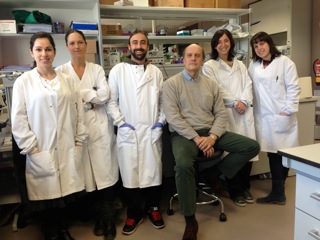
Molecular Signalling |
|
|
|
|


 Principal Investigator:
Principal Investigator:
Dr. Piero Crespo, Full Professor CSIC
 Other personnel:
Other personnel:
Lorena Agudo Ibáñez, postdoctoral
Berta Casar Martínez, postdoctoral
Paula Colón Bolea, predoctoral
Iñaki Jiménez Gómez, predoctoral
 Research lines:
Research lines:
Spatial regulation of Ras-ERK signals in physiological processes and in cancer
 Funding:
Funding:
“Las interacciones entre proteínas scaffolds y dímeros de ERK como dianas antitumorales”
BFU2011-23807. 2012-2014.
 Relevant publications (last 10 years)
Relevant publications (last 10 years)
From a total of 80 publications:
Casar B., Rodríguez J., Gibor G., Seger R., and Crespo P. “Mxi2 sustains ERK1/2 phosphorylation levels in the nucleus by preventing ERK1/2 binding to phosphatases”. Biochem. J., 441, 571-578. (2012).
Matallanas D., Romano D., Al-Mulla F., O’Neil E., Al-Ali W, Crespo P., Doyle B, Nixon B, Samson O, Drosten M., Barbacid M., and Kolch W. “K-Ras oncogene addiction requires the presence of the wildtype allele, EGF signalling and shutdown of MST2 signalling”. Mol. Cell, 44, 893-906. (2011).
Rodríguez J. and Crespo P. “Working without kinase activity: phosphotransfer-independent functions of Extracellular Signal-Regulated kinases”. Sci. Signal., 4, re3 (2011).
Crespo P., Calvo F., and Sanz-Moreno V. “Ras and Rho GTPases on the move: the RasGRF connection”. BioArchitecture, 1, 200-204. (2011).
Calvo F., Sanz-Moreno V, Agudo-Ibáñez L., Wallberg F., Sahai E., Marshall C.J., and Crespo P. “Ras GEFs as inhibitors of Rho GTPases: RasGRF suppresses Cdc42-mediated tumor cell movement, cytoskeletal dynamics and transformation”. Nat. Cell Biol. 13, 819-826. (2011). Seleccionado pro The Faculty of 1000).
Arozarena I., Calvo F., Agudo-Ibañez L. and Crespo P. “An actor on many stages: Ras subcellular localization, site-specific regulation and functions”. Genes & Cancer.182-194. (2011).
Matallanas D., and Crespo P. “New druggable targets in the Ras pathway?. Curr. Opin. Mol. Ther. 12, 674-683. (2010).
Rodríguez J., Calvo F., González J.M., Casar B., Andrés V. and Crespo P., “ERK1/2 MAP kinases promote cell cycle entry by rapid, kinase-independent disruption of Retinoblastoma–LaminA complexes”. J. Cell Biol. 191, 967-979. (2010). (Editorial en el mismo número; Editorial en Science Sig. 3, ec371 2010; Seleccionado por The Faculty of 1000).
Chiariello M., Vaqué J.P., Crespo P., and Gutkind J.S. “Activation of Ras and Rho GTPases and MAP kinases by G-Protein-coupled receptors”. Meths. Mol. Biol. 661, 137-150. (2010).
Pinto A. and Crespo P. “Analysis of ERKs dimerization by electrophoresis”. Meths. Mol. Biol. 661, 335-342. (2010).
Calvo F., Agudo-Ibáñez L., and Crespo P. “The Ras-ERK pathway: understanding site-specific signaling provides hope of new anti-tumour therapies”. Bioessays. 32, 412-421. (2010).
Calvo F., and Crespo P. “Structural and spatial determinants regulating TC-21 activation by RasGRF family Nucleotide Exchange Factors”. Mol. Biol. Cell, 20, 4289-4302. (2009).
Casar B., Pinto A., and Crespo P. “ERK dimers and scaffold proteins: unexpected partners for a forgotten (cytoplasmic) task”. Cell Cycle, 8, 1007-1013. (2009).
Casar B., Arozarena I., Sanz-Moreno V., Pinto A., Agudo-Ibáñez L., Marais R., Lewis R.E., Berciano M.T. and Crespo P. “Ras subcellular localization defines ERKs substrate specificity though distinct utilization of scaffold proteins”. Mol. Cell. Biol., 29, 1338-1353. (2009). (Seleccionado por The Faculty of 1000).
González J.M., Navarro A., Casar B., Crespo P., and Andrés V. “Fast regulation of AP-1 activity through interaction of lamin A/C, ERK 1/2 and c-Fos at the nuclear envelope”. J. Cell Biol., 183, 653-666. (2008). (Seleccionado por The Faculty of 1000).
Casar B., Pinto A., and Crespo P. “Essential role of ERK dimers in the activation of cytoplasmic but not nuclear substrates by ERK-scaffold complexes”. Mol. Cell, 31, 708-721. (2008). (Seleccionado por The Faculty of 1000; Editorial en Science Sig. 1, ec315 2008).
Vaqué J.P., Fernández-García B., García P., Calvo F., Crespo P, Marín M.C. and León J., “c-Myc inhibits Ras-mediated differentiation of neuroendocrine cells by blocking c-Jun up-regulation”. Mol. Cancer Res., 6, 325-339. (2008).
Agudo-Ibáñez L., Núñez F., Calvo F., Berenjeno I.M, Bustelo X.R., and Crespo P. “Transcriptomal profiling of site-specific Ras signals”. Cell. Signal., 19, 2264-2276. (2007).
Martínez S.E., Lázaro-Diéguez F., Selva J., Calvo F., Renau-Piquéras J., Crespo P., Claro E., and Egea G. “Lysophosphatidic acid rescues Rho A activation and phosphoinositide levels in astrocytes exposed to ethanol”. J. Neurochem., 102, 1044-1052. (2007).
Casar B., Sanz-Moreno V., Yazicioglu M.N., Rodríguez J., Berciano M.T., Lafarga M., Cobb M.H., and Crespo P. “Mxi2 promotes stimulus-independent ERK nuclear translocation”. EMBO J., 26, 635-646. (2007). (Seleccionado por The Faculty of 1000).
Peregrín S., Jurado M, Sanz-Moreno V, Ruiz-Gómez A, Crespo P., Mayor, jr F. and Murga C. “Phosphorylation of p38 by GRK2 at the docking groove unveils a novel mechanism for inactivating p38 MAPK”. Curr. Biol., 16, 2042-2047. (2006). (Seleccionado por The Faculty of 1000).
Matallanas D., Sanz-Moreno V., Arozarena I., Calvo F., Agudo-Ibáñez L., Santos E., Berciano M.T., and Crespo P. “Distinct utilization of effectors and biological outcomes resulting from site-specific Ras activation: Ras functions in lipid rafts and Golgi complex are dispensable for proliferation and transformation”. Mol. Cell. Biol., 26, 100-116. (2006).
 Contact:
Contact:
Dr. Piero Crespo
Phone: (+34) 942 200959 / Fax : (+34) 942 266399
Email: crespop@unican.es
Mailing address: IBBTEC. C/ Albert Einstein 22, PCTCAN, 39011 Santander